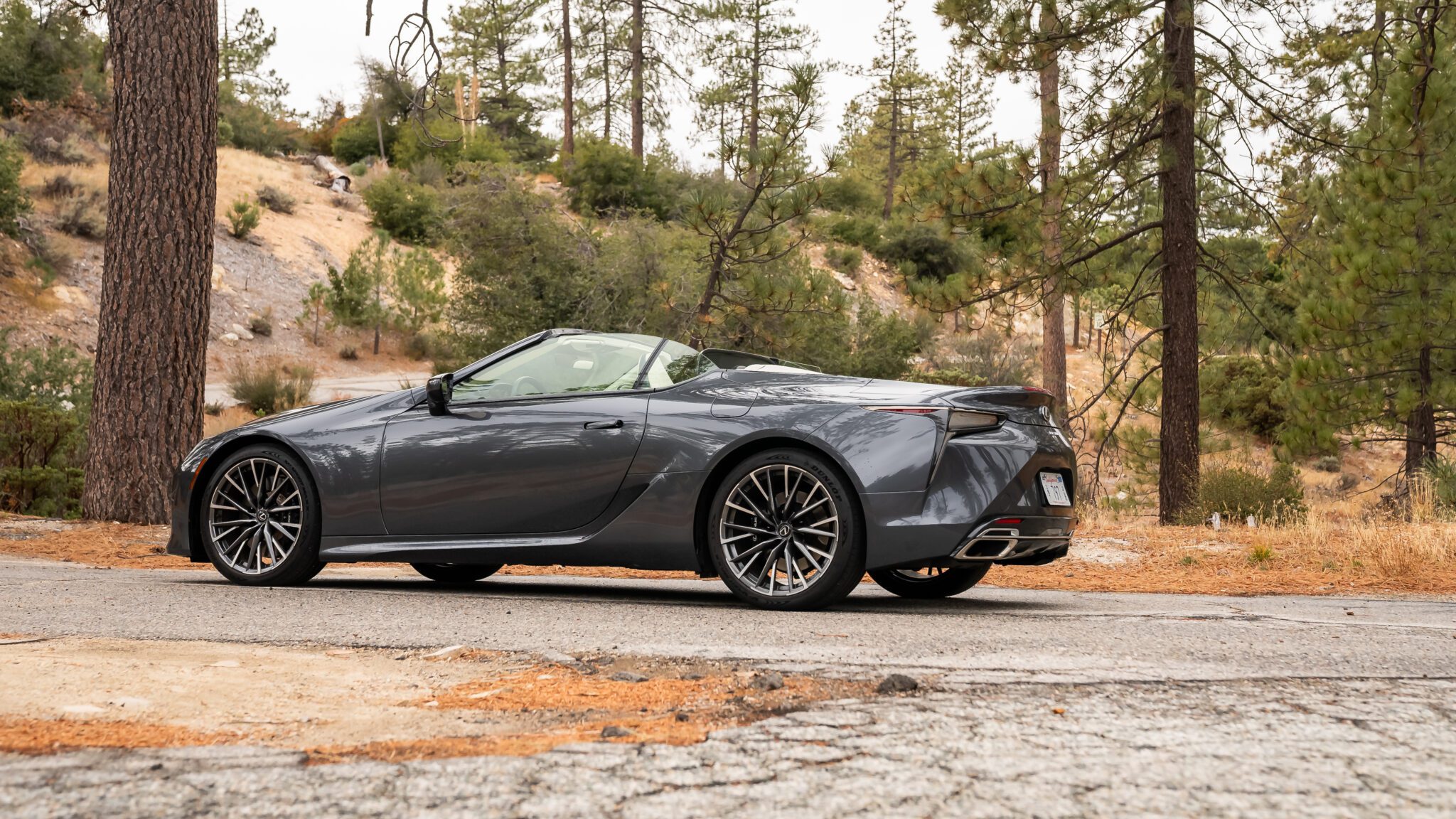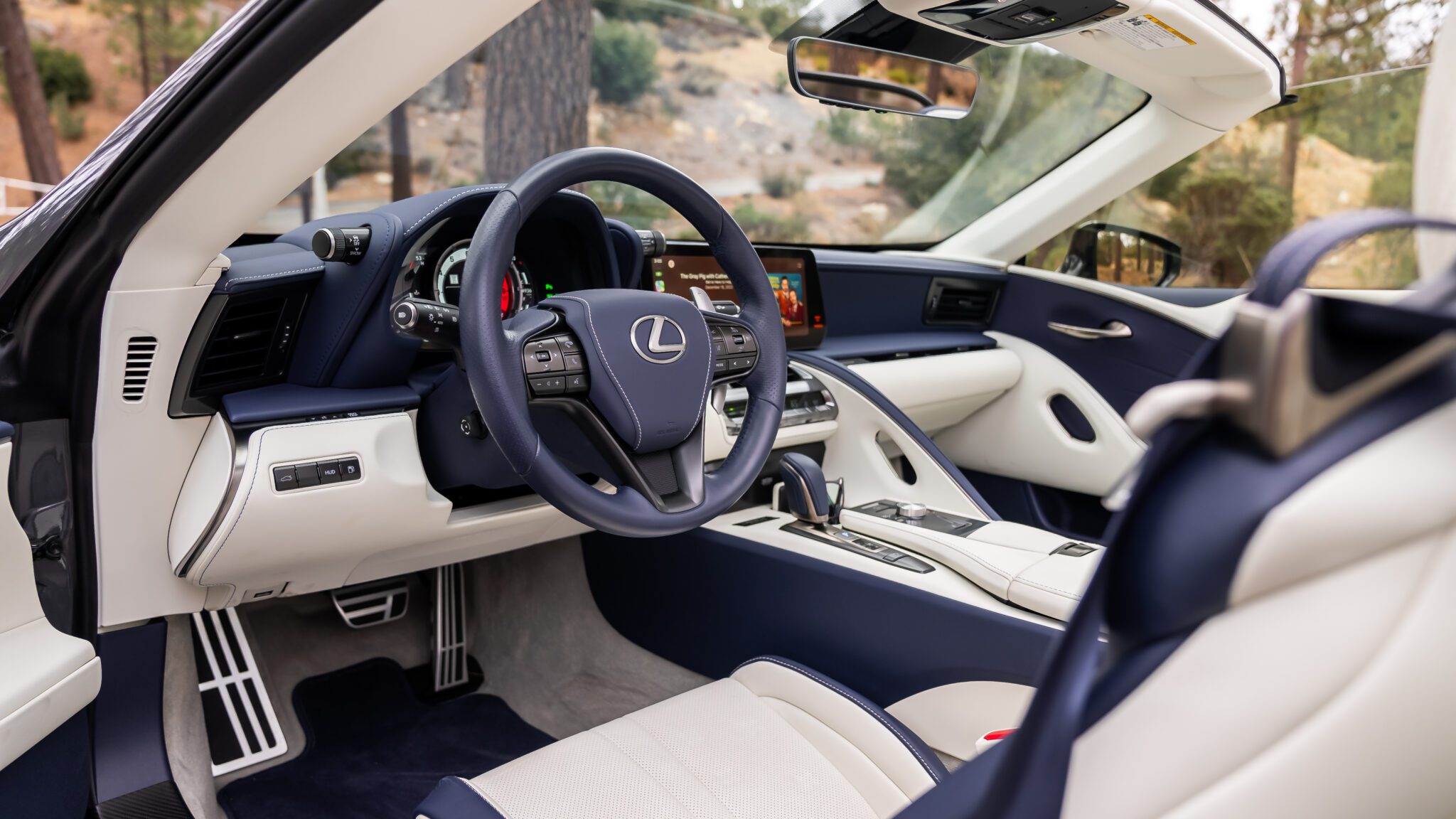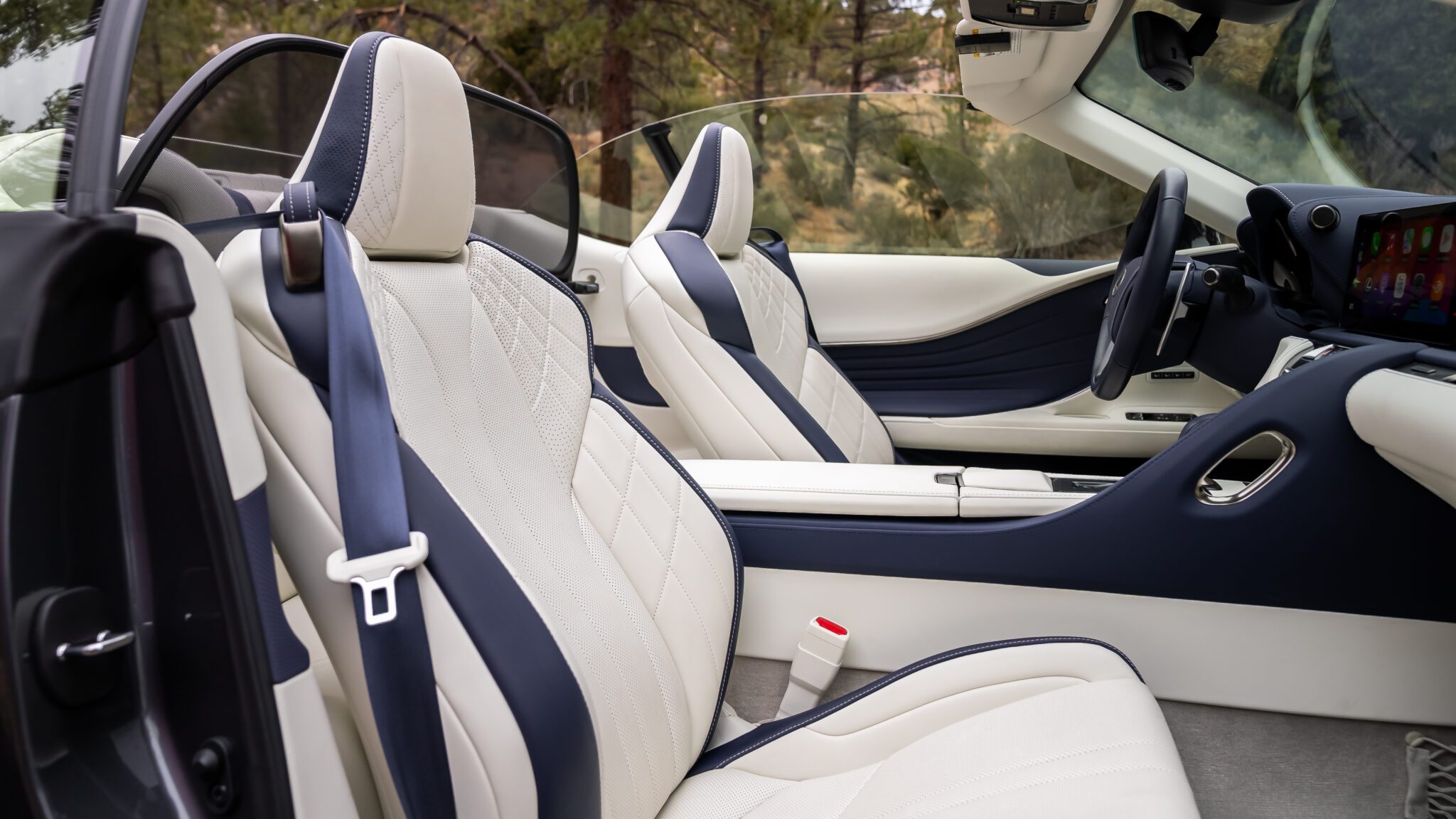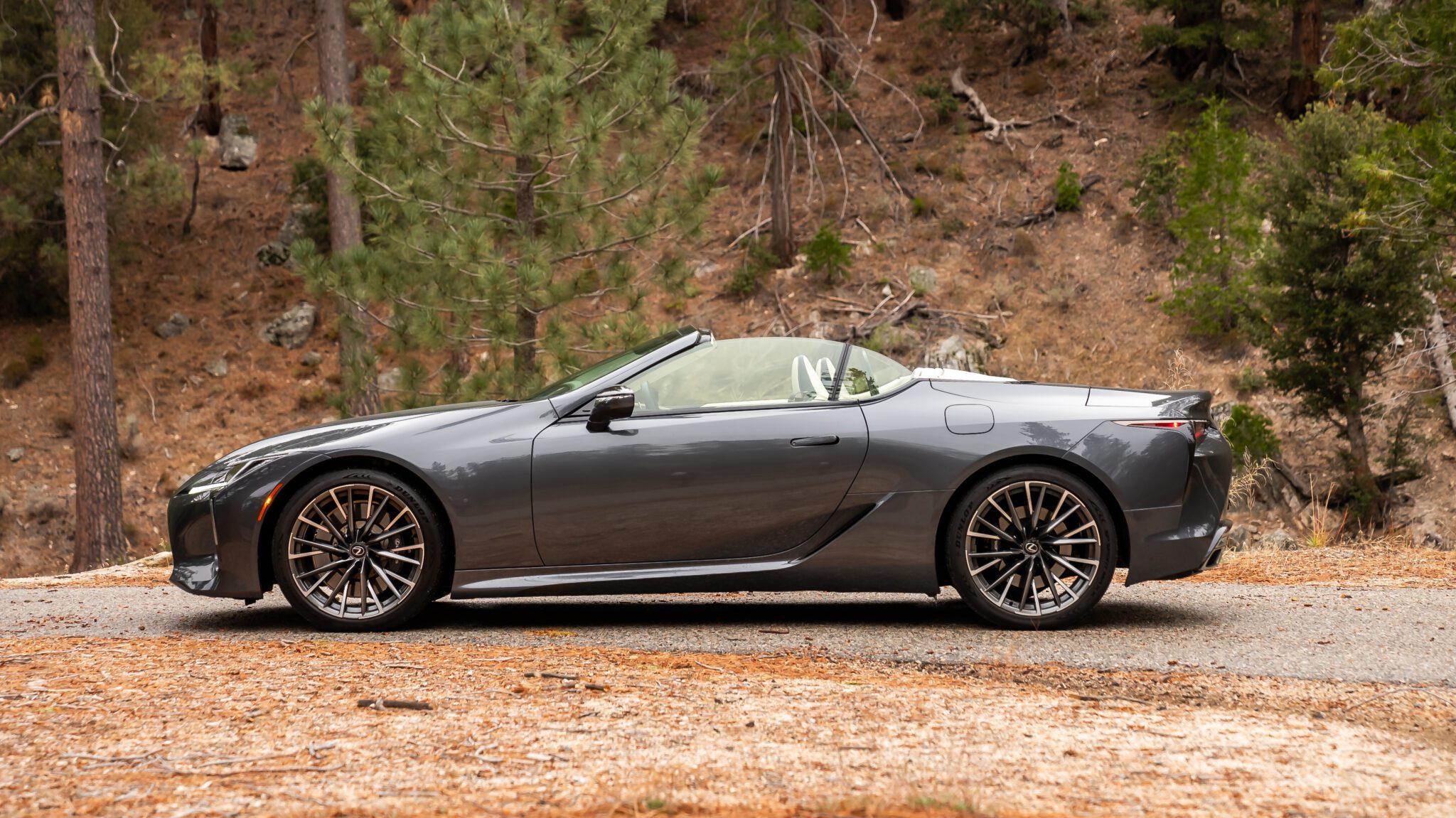If you read the 2024 Lexus LC 500’s spec sheet, you’ll find a car that represents an ideal grand-tourer from a bygone world. Much like the Bentley Continental GT of the early 2000s, the LC 500 serves as the carmaker’s flagship coupe and a product built to court younger buyers. Its cabin is beautifully trimmed, with practically every surface covered in semi-aniline blue and white leather. Its spring and shock multilink suspension delivers a comfortable and controlled ride. Even its engine, a 5.0-liter naturally-aspirated V-8 that generates 471 horsepower, produces a raspy old-school engine note reminiscent of an 80s Aston Martin V8 Vantage. And because Lexus green-lit 2012’s LF-LC concept for production without significant changes, it blends old-school, long-hooded GT proportions with modern, angular styling. In almost every way, it’s an ideal GT. Why, then, are so few people buying it?
Don’t look to Lexus’s product planners for answers. As the LC enters its seventh year of production, its sales figures continue to struggle. Last year, Lexus managed to sell just 1,761 units of its flagship product, including its coupe, convertible, and hybrid variants. In the same period, BMW’s 8 Series racked up 5,752 sales, while Porsche sold 11,728 911s. Yet, while the market for six-figure luxury vehicles continues to expand, it’s as if this massive wave of growth has all but missed the LC.
The question posed above resurfaced constantly throughout our week behind the wheel of a well-optioned LC 500 Convertible equipped with a new Bespoke Build Package. Was the LC’s struggle nothing more than market preferences placing more value on luxurious SUVs, or did Lexus’ flagship fail to connect with the market of affluent young buyers it was built to target? As it turns out, to find answers, we have to examine what the LC could’ve been.
Although the Lexus LC 500 has been on sale since 2017 ( the droptop in 2020), it hasn’t changed much. As our Cloudburst Gray tester shows, aside from adding a new set of multi-spoke 21-inch wheels, its exterior remains virtually identical seven years on. While it may have been able to bank on its concept-car-looks back when new, direct competitors like the BMW 8-Sereies and Porsche 911 have received significant updates in the interim. For 2024, Lexus updated the LC’s list of available colors to include Ultrasonic Blue Mica 2.0 and Copper Crest, while its infotainment screen gets not just sleeker, more user-friendly software but a larger 12.3-inch display. The most significant update, however, is the inclusion of a Bespoke Build option, which was introduced to expand this flagship’s customization options.

Unlike its European competitors, the Lexus LC 500 offers a relatively short list of extras. It comes standard with all its best equipment and only offers a handful of interior, wheel, and exterior options. It may sound counterintuitive, but this focus on value lures in the $40,000 ES buyer, not someone looking to part with six figures for a flagship GT. A prospective buyer considering a car as flashy and as lavish as the LC wants the ability to customize it, even if just with add-ons that do nothing more than show off how expensive they are. This is a gap options like the $5,500 Bespoke Build are starting to fill.
In our tester’s case, the clearest example is its $1,900 blue and white leather interior, an undeniably flamboyant and very un-Lexus-like color combo that suits this car perfectly. Unfortunately, it’s only available for the Convertible model. The coupes get a new Rioja Red shade plus the previously offered Black and Toasted Caramel colors. Other touches include darkened chrome and a carbon scuff plate. Although the LC 500 only offers Black and Sand colors for its canvas top, the Bespoke Build expands this list to include Dark Rose and Blue. Skip this new package, and you can access the LC’s best and brightest standard colors like Flare Yellow, Copper Crest, and Ultrasonic Blue Mica 2.0.

While these new extras are a step in the right direction, there’s value in letting a buyer’s imagination go wild. And as Bugatti’s Frank Heyl told us during an interview at Car Week last year, offering more flexibility when customizing a luxury product is now more critical than ever.
If you’re not buying a Lexus LC 500 for its looks alone, you’re doing so for the engine that powers it. Like most buyers, we’ll skip over the forgettable hybrid model and dive straight into the range-topper’s naturally aspirated V8. It’s a rarity in an industry destined to downsize and turbocharge to meet stricter emissions regulations, but in the LC’s case, its old-school lump is central to its driving experience. Although it’ll develop a healthy 471 horses, it does so at 7,100 rpm, which forces you to repeatedly chase its redline before it truly gets going. Even its 398 pound-feet of torque doesn’t come in at 4,800 rpm. Thankfully, staying in the 500’s powerband once you get there is easy thanks to its 10-speed automatic and its closely spaced gears.

Despite having to route all of that power to the rear wheels, the fact that this V8 requires a slow build before it bites allows the LC’s back tires to put all of its power down without so much as a twitch from its back end. On its best day, the convertible LC sprints to 60 mph in 4.6 seconds and tops out at an electronically limited 168 mph. While it might be 0.2 seconds to 60 than the coupe, an indistinguishable amount, it has the distinct benefit of offering up glorious V8 noises anytime your foot nears the throttle. In Sport+ mode, with its valves fully open, this luxurious cruiser wakes up and becomes muscle car loud. Its note is bassy, rumbly, and charmingly old-school.
While this V8’s sidestepping of broader industry downsizing trends is its biggest strength, it’s also its greatest weakness. Compared to its turbocharged competitors, the Lexus LC 500 can often feel downright slow thanks to its lack of available torque. Take BMW’s 840i as an example, an inline-six powered GT that’s far from a flagship product, yet just about matches the LC to 60 mph despite counting on 136 fewer horses. Puttering around town, the 500 feels the slowest out of its direct competitors. The playing field only levels on an empty back road at higher revs.

Pick up the pace, and the gap between the big Lexus and its European rivals grows. While our tester lacked a $460 package that adds firmer dampers and a limited-slip differential, they wouldn’t make much of a difference in all but extreme scenarios. Around tighter bends, the LC’s front end isn’t particularly agile, nor is its steering precise. And although it weighs up nicely in the more aggressive drive modes, it transmits very little feedback. The same goes for its brakes, which are smooth and quiet around town but tend to fade quickly at higher speeds. The result is that while the LC can carry a rapid pace up a canyon road, it leaves its driver wholly disconnected from the experience.
What the Lexus LC 500 may lack in sharpness, it makes up for with excellent dampening and body control. As you’d expect from a big GT, it tackles a bumpy back road gracefully. It soaks up imperfections, both big and small, all while remaining quite balanced. The LC’s proficiency on a back road is primarily due to its revised suspension, which Lexus tuned to account for this 4,540-pound convertible’s 200-pound gians over its coupe counterpart. These benefits carry over to the real world, where the LC proves its dominance as a high-speed cruiser. It’s cushy but not floaty and feels supremely planted at higher speeds. And although firmer dampers might sharpen its response slightly, this softer setup allows it to excel where it truly counts.

Like with practically all modern convertibles, you can’t feel the LC’s chassis flex in most scenarios. Only when tackling driveways with obscenely steep angles did unsettling, crunching noises fill the cabin. Whether at higher speeds or just cruising around town, the Convertible is as quiet as the coupe, and given the unfettered access to V8 noises it provides, it’s the one to have. Plus, it folds in 15 seconds at up to 31 mph and doesn’t further reduce this GT’s already tiny 3.4 cubic feet of trunk space.
Step inside, and the Lexus LC 500 greets you with its blue and white leather cabin with perforated front seats for cooling. To an extent, it’s comparable to what you’d get in a Bentley Continental GT. And because of this, practically everything you see and interact with feels expensive, minus some of the center console’s plastic switchgear and Lexus’ terrible touchpad control. For 2024, a new bright and colorful 12.3-inch infotainment display adorns the dashboard and adds much-needed touchscreen functionality, circumventing the need to use Lexus’ cumbersome touchpad.

On the surface, Lexus’ flagship checks all the boxes. It’s stunning, quiet, comfortable, and impeccably well-built. Should you be willing to part with the $117,660 ($106,350 base price) our tester commands, it’s probably the most rational way to spend the cash. After all, you get practically everything as standard. Even “fully optioned,” Lexus’ flagship significantly undercuts its direct rivals.
The problem is that while you probably should buy the Lexus, it struggles to make you want to. Despite its many excellent attributes, the LC struggles to communicate these strengths to consumers like its European competitors can. As a result, it doesn’t immediately come across as the luxury item it truly is. Be it due to Lexus’ lack of brand cache at the higher end of the price spectrum or the 500’s relative lack of flexibility when personalizing, it fails to connect with a broader customer base.

A major contributing factor is also the need for significant updates. While the Lexus LC 500 is, at its core, a solid GT, it sits idle at the top of the Lexus food chain. Meanwhile, competitors like BMW, Porsche, and Mercedes-Benz have continuously updated their offerings and expanded their ranges with high-performance variants and, in general, more opportunities to make your six-figure GT feel unique.
At this price point, and when trying to court a customer base inundated with excellent options, offering a well-built and equipped product at a reasonable price point doesn’t draw attention as it does in lower segments. Anyone willing to spend six figures on a big GT is looking for something more, and despite the LC 500 being practically faultless from behind the wheel, none of it matters if the customer base that should be salivating at the chance to have one has all but forgotten it exists.

